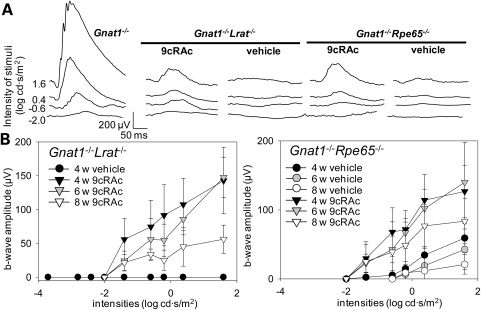Figure 4.
Functional evaluation of cone photoreceptor cells in Gnat1−/−Rpe65−/− and Gnat1−/−Lrat−/− mice after 9-cis-retinyl acetate (9cRAc) treatment. ERG responses were obtained in 4-, 6- and 8-week-old Gnat1−/−Rpe65−/− and Gnat1−/−Lrat−/− mice on the day following the last day of treatment with 9-cis-retinyl acetate (from P10 to P21, IP injection of 1.0 µg/g body weight; from P22 to P56, gavage with 50 µg/g body weight; see Materials and Methods for regimen). (A) Representative traces of scotopic single flash ERG recordings are shown for Gnat1−/− and for both strains of 4-week-old double knockout mice either treated with 9-cis-retinyl acetate or vehicle solution. Comparison of these recordings shows that both double knockout strains had reduced responses relative to the Gnat1−/− mouse and that treatment with 9-cis-retinyl acetate partially preserved ERG responses in both double knockout strains. (B) ERG b-wave amplitudes indicate that treatments with 9-cis-retinyl acetate improved responses in Gnat1−/−Lrat−/− mice (left panel) and Gnat1−/−Rpe65−/− mice (right panel) at 4, 6 and 8 weeks of age. No b-wave responses were detected in vehicle-treated Gnat1−/−Lrat−/− mice at 4, 6 and 8 weeks of age (only data from 4-week-old Gnat1−/−Lrat−/− mice are presented). Gnat1−/−Rpe65−/− mice showed some residual responses during the experimental period. Bars indicate SDs; n = 4–7, P < 0.0001.

